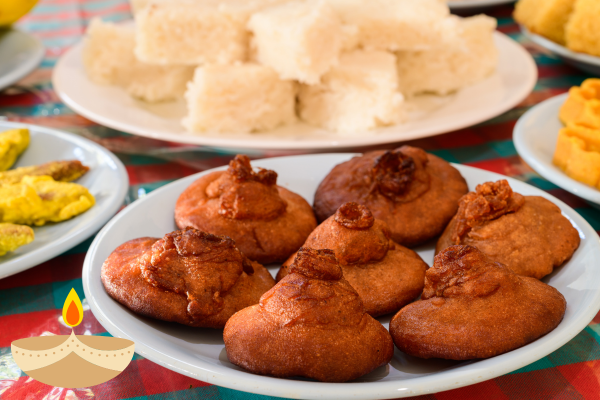Awurudu Kema: Culinary Delights of Sinhala New Year – By Nadeeka – eLanka

Sinhala New Year, or Aluth Avurudu, is not only a time for cultural celebrations and traditional rituals but also a feast for the senses, especially the taste buds. “Awurudu Kema,” which translates to New Year dishes, plays a central role in Sinhala New Year festivities, bringing families together to enjoy a delectable array of traditional delicacies. In this article, we delve into the culinary delights of Sinhala New Year, exploring the significance of these dishes and the joy they bring to the celebrations.
1. Kiribath (Milk Rice): No Sinhala New Year celebration is complete without Kiribath, a creamy and fragrant dish made from rice and coconut milk. Kiribath holds a special place in the hearts of Sri Lankans, symbolizing prosperity and abundance for the year ahead. It is traditionally served as the first meal of the New Year, accompanied by a spread of savory and sweet accompaniments.
2. Kavum and Kokis: Kavum and Kokis are iconic Sinhala New Year sweets, cherished for their crispy textures and indulgent flavors. Kavum, made from rice flour, jaggery, and coconut, is deep-fried to perfection, resulting in a golden-brown delicacy with a hint of sweetness. Kokis, on the other hand, are intricately shaped fried cookies made from rice flour and coconut milk, offering a delightful crunch with every bite.
3. Athirasa: Athirasa is another beloved sweet treat enjoyed during Sinhala New Year celebrations. These small, round cakes are made from a mixture of rice flour, treacle, and spices, then deep-fried until golden and crispy. Athirasa delights the palate with its rich, caramel-like flavor and satisfying texture, making it a favorite among young and old alike.
4. Mung Kavum: Mung Kavum, also known as Green Gram Cake, is a traditional Sinhala New Year sweet made from green gram flour, jaggery, and coconut. The mixture is shaped into small balls, flattened, and deep-fried until golden and crisp. Mung Kavum offers a delightful contrast of textures, with a crunchy exterior giving way to a soft and chewy center.
5. Aggala: Aggala is a unique Sinhala New Year delicacy that combines the flavors of coconut, jaggery, and rice flour in a delightful pastry. These crescent-shaped treats are filled with a sweet coconut and jaggery mixture, then deep-fried to perfection. Aggala delights the senses with its aromatic coconut filling and crispy exterior, making it a must-have during Aluth Avurudu celebrations.
6. Aasmi: Aasmi is a delicate and intricately designed sweet that graces the tables during Sinhala New Year celebrations. Made from rice flour, coconut milk, and sugar syrup, Aasmi is deep-fried to achieve its signature golden hue and intricate patterns. This sweet delicacy is a feast for both the eyes and the taste buds, symbolizing prosperity and good fortune for the New Year.
7. Kiri Toffee: Kiri Toffee, or milk toffee, is a beloved sweet treat enjoyed by children and adults alike during Sinhala New Year celebrations. Made from condensed milk, sugar, and butter, Kiri Toffee is cooked to a soft and chewy consistency before being cut into bite-sized pieces. This indulgent confection is a perennial favorite, offering a taste of nostalgia and sweetness to the festivities.
8. Welithalapa: Welithalapa is a traditional Sinhala New Year snack that combines the flavors of coconut, jaggery, and rice flour in a delightful pastry. The dough is filled with a sweet coconut and jaggery mixture, then wrapped in banana leaves and steamed to perfection. Welithalapa delights the palate with its moist and tender texture, making it a popular choice among those with a sweet tooth.
9. Thalaguli: Thalaguli is a crunchy and nutritious snack enjoyed during Sinhala New Year celebrations. Made from a mixture of sesame seeds, jaggery, and rice flour, Thalaguli is shaped into small balls and toasted until golden and fragrant. This wholesome snack is not only delicious but also packed with energy, making it an ideal treat for sharing with family and friends during the festive season.
Conclusion: In conclusion, Awurudu Kema, or the culinary delights of Sinhala New Year, play a vital role in enriching the festive atmosphere and fostering a sense of joy and togetherness among families and communities. From Kiribath to Kavum, these traditional dishes evoke a sense of nostalgia and cultural pride, reminding us of the rich culinary heritage of Sri Lanka. As we gather around the table to savor these delectable treats, let us cherish the traditions that bind us together and usher in the New Year with gratitude, happiness, and abundance.







